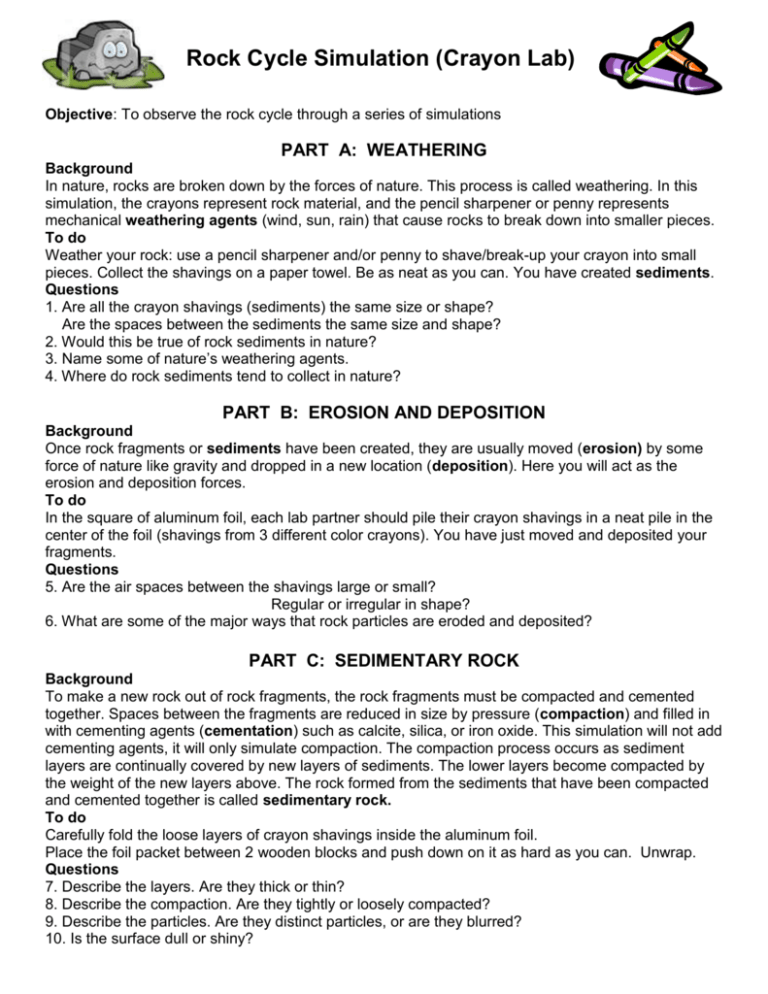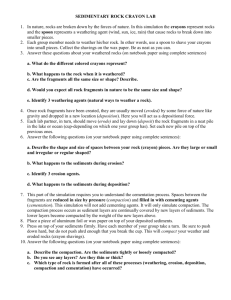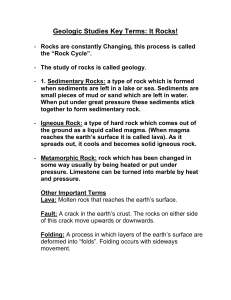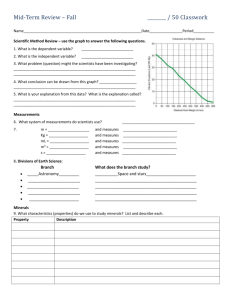Rock Cycle Simulation (Crayon Lab)
advertisement

Rock Cycle Simulation (Crayon Lab) Objective: To observe the rock cycle through a series of simulations PART A: WEATHERING Background In nature, rocks are broken down by the forces of nature. This process is called weathering. In this simulation, the crayons represent rock material, and the pencil sharpener or penny represents mechanical weathering agents (wind, sun, rain) that cause rocks to break down into smaller pieces. To do Weather your rock: use a pencil sharpener and/or penny to shave/break-up your crayon into small pieces. Collect the shavings on a paper towel. Be as neat as you can. You have created sediments. Questions 1. Are all the crayon shavings (sediments) the same size or shape? Are the spaces between the sediments the same size and shape? 2. Would this be true of rock sediments in nature? 3. Name some of nature’s weathering agents. 4. Where do rock sediments tend to collect in nature? PART B: EROSION AND DEPOSITION Background Once rock fragments or sediments have been created, they are usually moved (erosion) by some force of nature like gravity and dropped in a new location (deposition). Here you will act as the erosion and deposition forces. To do In the square of aluminum foil, each lab partner should pile their crayon shavings in a neat pile in the center of the foil (shavings from 3 different color crayons). You have just moved and deposited your fragments. Questions 5. Are the air spaces between the shavings large or small? Regular or irregular in shape? 6. What are some of the major ways that rock particles are eroded and deposited? PART C: SEDIMENTARY ROCK Background To make a new rock out of rock fragments, the rock fragments must be compacted and cemented together. Spaces between the fragments are reduced in size by pressure (compaction) and filled in with cementing agents (cementation) such as calcite, silica, or iron oxide. This simulation will not add cementing agents, it will only simulate compaction. The compaction process occurs as sediment layers are continually covered by new layers of sediments. The lower layers become compacted by the weight of the new layers above. The rock formed from the sediments that have been compacted and cemented together is called sedimentary rock. To do Carefully fold the loose layers of crayon shavings inside the aluminum foil. Place the foil packet between 2 wooden blocks and push down on it as hard as you can. Unwrap. Questions 7. Describe the layers. Are they thick or thin? 8. Describe the compaction. Are they tightly or loosely compacted? 9. Describe the particles. Are they distinct particles, or are they blurred? 10. Is the surface dull or shiny? PART D: METAMORPHIC ROCK Background Deep within the earth, pressure and temperatures increase. The heat and pressure cause minerals and rocks to change in size or shape, or separate into parallel bands. The rock can even flow like a plastic material, and minerals can change into other minerals. The change from one type of rock to another is called metamorphism, and the rocks formed are called metamorphic rocks. To do Rewrap the sedimentary rock type crayons in the aluminum foil. Turn the hot plate to low (“2”). Place it on the hot plate for about 10 seconds. Turn off the hot plate. Remove from hot plate. Allow it to cool for 30 seconds. Place foil between the wood blocks and apply even more pressure. Have each group member apply pressure (try standing on the block). Let cool, & unwrap. Questions 11. Describe the layers. Are they thin or thick? 12. Describe the compaction. Are they tightly or loosely compacted? 13. Describe the particles. Are they distinct or blurred? 14. Is the surface dull or shiny? What might be the cause of this? PART E: IGNEOUS ROCK Background Igneous rocks form deep within the earth. They are formed when magma (called lava if it comes to the surface) cools and hardens. The rocks are called extrusive if they come to the surface during a volcanic eruption. Extrusive rocks cool rapidly from lava into rocks. Igneous rocks are called intrusive if they cool slowly beneath the earth’s surface, often inside other rocks. Eventually they are exposed by erosion. To do Turn the hot plate to medium (“5”). Place the rest of your crayon shavings into an aluminum cupcake pan and place it on the hot plate. Watch the pan until crayon begins to melt around the edges (about 30 seconds). Turn off the hot plate. Remove from hot plate. Allow it to cool completely (3 minutes). Pull gently on the sides of the cupcake pan to loosen & flip over onto a paper towel to remove your igneous crayon rock. Questions 15. Which group simulates a rock that comes to the surface and cools quickly in the air? 16. Which group represents a rock that cools deep beneath the surface? 17. What general statement can be made about crystal size and the speed of cooling? SUMMARY 18. Sedimentary Rocks-How are these rocks formed? Include the following terms in your explanation: weathering, compaction, cementation, deposition, and sediment. 19. Metamorphic Rocks-How are these rocks formed? Include the following terms in your explanation: heat, pressure, and metamorphism. 20. Igneous Rocks-How are these rocks formed? Include the following terms in your explanation: magma, lava, and crystallization. Name: Date: Block: Rock Cycle Simulation (Crayon Lab) Guiding Questions PART A: WEATHERING What did you do in this step? ___________________________________________ 1. Are all your crayon shavings (sediments) the same size or shape? 2. Would this be true of rock sediments in nature? 3. Name some of nature’s weathering agents. 4. Describe the appearance of your pile of crayon sediments. PART B: EROSION AND DEPOSITION What did you do in this step? ___________________________________________ 5. Where do rock sediments tend to collect in nature? 6. What are some of the major ways that rock particles are eroded and deposited? 7. Describe the appearance of your group’s collected crayon sediments. PART C: SEDIMENTARY ROCK What did you do in this step? ___________________________________________ 8. Describe the compaction. Are they tightly or loosely compacted? 9. Describe the particles. Are they distinct particles, or are they blurred? 10. Describe the appearance of your crayon sedimentary rock. PART D: METAMORPHIC ROCK What did you do in this step? ___________________________________________ 11. What is the source of the heat to make metamorphic rocks in nature? 12. What is the source of the pressure to make metamorphic rocks in nature? 13. Describe the appearance of your crayon metamorphic rock. PART E: IGNEOUS ROCK What did you do in this step? ___________________________________________ 14. Rocks that come to the surface and cools quickly in the air are made from lava & commonly found near volcanoes. Rocks that cool deep beneath the surface are made from magma, and may come to the surface at a later time. Which kind did you make? 15. Describe the appearance of your crayon igneous rock. SUMMARY 16. Sedimentary Rocks-How are these rocks formed? Key words to explain: weathering, compaction, cementation, deposition, and sediment. 17. Metamorphic Rocks-How are these rocks formed? Key words to explain: heat, pressure 18. Igneous Rocks-How are these rocks formed? Key words to explain: magma, lava 19. If you wanted to continue the rock cycle using the crayon you created, what would be the next step? What would it represent? Rock Cycle Simulation (Crayon Lab) Instructor Checklist Weathering Tools: o o o o o crayons pennies pencil sharpeners toothpicks (for jams in sharpeners) paper towels Pressure: o Wooden blocks (large pieces of 2”x4”) o Aluminum foil Heating / Cooling: o o o o o Hot plates aluminum cupcake tins (cut apart) petri dishes ice cubes water Clean-up: o LA’s Awesome Spray o Paper towels









